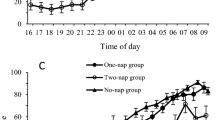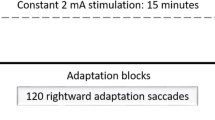Parameters of saccades (latency, amplitude, duration, and velocity) were measured using a saccadometer in 32 nurses (30 women and 2 men) before and after a night shift. The mean latency of saccades was found to significantly increase after this period (209.6 ± 6.84 vs. 188.6 ± 6.08 msec, P = 0.002); the same was found with respect to the saccade duration (55.0 ± 0.97 vs. 54.2 ± 1.23 msec, P < 0.05). Thus, stress and sleep deprivation noticeably influence the parameters of saccades; the latter, nonetheless, remain within a physiological range. Considering that a number of brain structures are involved in the control of saccade parameters, the above-described modulations of saccades can be potentially used as generalized indices characterizing the level of brain tiredness.
Similar content being viewed by others
References
R. J. Leigh and C. Kennard, “Using saccades as a research tool in the clinical neurosciences,” Brain, 127, Pt. 3, 460–477 (2004).
E. Przedpelska-Ober,” Zaburzenia ruchów gałek ocznych w chorobie Alzheimera,” Neurol. Neurochir. Pol., 40, No. 1, 34–41 (2006).
R. J. Krauzlis, “Recasting the Smooth Pursuit Eye Movement System,” J. Neurophysiol, 91: 591–603 (2004);
D. L. Sparks, “The brainstem control of saccadic eye movements,” Nat. Rev. Neurosci., 3, No. 12, 952-964 (2002).
Q. Yang, Z. Kapoula, E. Debay, et al., “Prolongation of latency of horizontal saccades in elderly is distance and task specific,” Vision Res., 46, No. 5, 751–759 (2006).
R. J. Leigh and D. S. Zee, The Neurology of Eye Movements, 4th edition, Oxford University Press, New York (2006).
D. Camors, Y. Trotter, P. Pouget, et al., “Visual straightahead preference in saccadic eye movements,” Sci. Rep., 6, 23124; doi: 10.1038/srep23124 (2016).
W. G. Bradley, R. B. Droff, G. M. Fenichel, and J. Jankovic, Neurologia w Praktyce Klinicznej. Zasady Diagnostyki i Postępowania, A. Prusiński, ed., Vol. 1, Chapt. 39, Wydawnictwo Czelaj Sp.z o. o., Lublin (2006).
Author information
Authors and Affiliations
Corresponding author
Rights and permissions
About this article
Cite this article
Skrzypek, A., Szeliga, M., Jabłoński, K. et al. Effect of Night Shift-Related Tiredness on Eye Saccades. Neurophysiology 49, 90–93 (2017). https://doi.org/10.1007/s11062-017-9633-y
Received:
Published:
Issue Date:
DOI: https://doi.org/10.1007/s11062-017-9633-y




